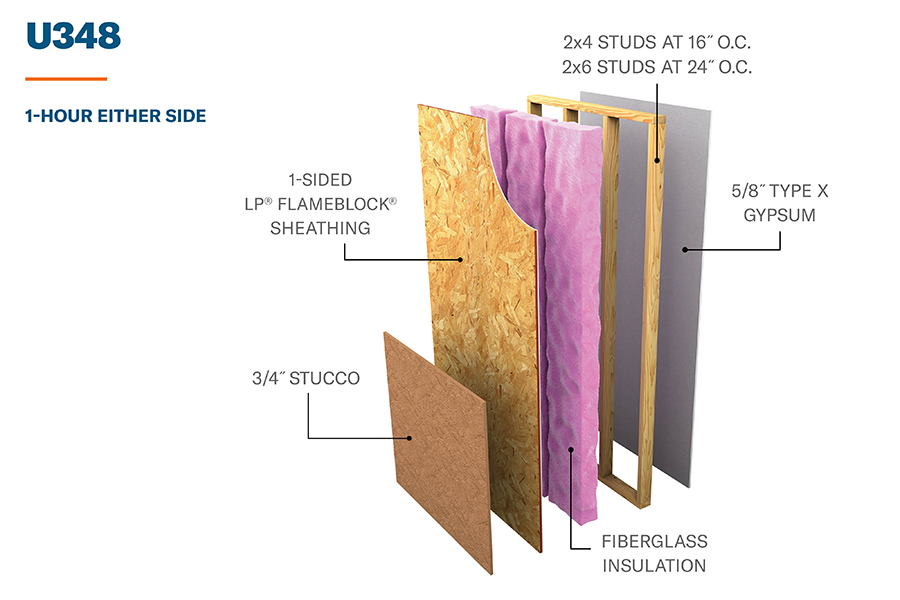Business Advice5 min
When to Use One-Sided LP® FlameBlock® Vs. Two-Sided LP® FlameBlock® Sheathing
In the construction process, there are many factors to consider. Among these factors is whether to use one-sided LP® FlameBlock® Fire-Rated Sheathing or two-sided LP FlameBlock sheathing. To help explain the reasons one assembly is used over another, we caught up with Scott Johnson, Manager, Construction Services at LP Building Solutions.
Before diving into whether to use LP FlameBlock two-sided sheathing or one-sided sheathing, let’s take a look at the features and functions of this innovative material.
How Louisiana-Pacific Designs LP FlameBlock 2-Sided and 1-Sided Sheathing
LP FlameBlock Fire-Rated Sheathing combines flame-spread resistance and burn-through resistance in a single panel. The fire-rated sheathing is evaluated to meet code requirements for fire-resistant construction and does not require reductions in strength. LP FlameBlock sheathing has the versatility to be used in most types of construction and is a listed component in fire-resistance-rated wall assemblies.
Both one-sided and two-sided LP FlameBlock OSB sheathing are favored among contractors because they can help speed construction time and help reduce labor and material costs by potentially eliminating a layer of gypsum.
To make LP FlameBlock panels, LP’s proprietary non-combustible, fiberglass-reinforced Pyrotite® coating is applied to the OSB panels, combining flame-spread and burn-through resistance.
Differences Between One-Sided LP FlameBlock Assemblies and Two-Sided LP FlameBlock Assemblies
The primary difference between one-sided and two-sided panels is simply whether the proprietary coating is applied to one side or both sides of the panels. It’s the Pyrotite coating that gives LP FlameBlock sheathing its fire resistance.
So how do you choose between the two? “This is generally dictated by the assembly, application and the construction type,” says Johnson.
“For walls there are two things to check: the first is the UL assembly requirement. The second is to consider the type of construction and application you’re using,” says Johnson.
However, there are exceptions for determining to use one-sided or two-sided sheathing based on the UL listing. “For example, there are UL assemblies that require only one-sided. But if that assembly is for an exterior wall in Type III construction, two-sided LP FlameBlock panels must be used. Always reference the Applications section of ESR-1365 on where two-sided FlameBlock sheathing is required,” says Johnson.
“Again, factors such as type of construction, occupancy group and fire separation distance will dictate fire-resistant requirements,” he adds.
Example of One-Sided vs. Two-Sided LP FlameBlock Fire-Resistant Panels
Johnson stresses if the UL assembly notes one-sided FlameBlock sheathing and the Applications section (Section 4.2) of ESR-1365 notes two-sided FlameBlock sheathing is required, follow the requirements in the ESR-1365.

“The ESR will always govern over the assembly if the two-sided LP FlameBlock sheathing is required. For example, the UL Design U348 only requires one-sided LP FlameBlock sheathing. But if that assembly is used for an exterior wall in Type III construction, two-sided LP FlameBlock sheathing is required. This requirement is noted in Section 4.2 of ESR-1365,” says Johnson.
UL Design No. V340 assembly is another example where, when installed in Type III construction for an exterior wall, two-sided LP FlameBlock sheathing is required.
For more on LP FlameBlock fire-rated assemblies, LP offers this guide.
Continue Reading
News & Stories3 min
History of Partnership with Gary Sinise Foundation
The LP Foundation is a proud partner of the Gary Sinise Foundation, which supports wounded veterans in several ways. You can learn more about the LP Foundation here.
Business Solutions
4 minQ&A: How Home Orientation Impacts Continuous Insulation
There’s a lot to consider when it comes to building an energy-efficient home for your clients and the many nuances that change with each build—including its orientation to the sun. We sat down with Neil Freidberg, Building Science Manager at LP, to unpack the impact of home orientation on continuous insulation needs.
Resiliency Solutions
5 minHOW A RADIANT BARRIER CAN IMPROVE BURIED DUCT PERFORMANCE
One of the questions LP® Building Solutions gets from builders often is about burying ducts in attic insulation and whether combining radiant barrier sheathing with blown insulation over ductwork can benefit homeowners. As with most technical situations, the outcome depends on a nuanced approach. Let’s dig in and explore this question.
Sustainability Solutions
8 minHow to Drive Effective Communication and Collaboration on the Jobsite
Every jobsite has a ton of moving parts, from product shipments, supplies, and schedules to subcontractors and homeowners. It’s no wonder that many project teams can struggle to maintain quality jobsite communication and collaboration throughout the building process. And when communication slips, construction companies inevitably deal with costly errors, inefficient workflows, delayed projects, or wasted time, leaving clients and the team frustrated.